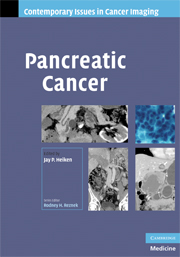Book contents
- Frontmatter
- Contents
- Series Foreword
- Preface to Pancreatic Cancer
- Contributors
- 1 Epidemiology and genetics of pancreatic cancer
- 2 Pathology of pancreatic neoplasms
- 3 Multi-detector row computed tomography (MDCT) techniques for imaging pancreatic neoplasms
- 4 Magnetic resonance imaging (MRI) techniques for evaluating pancreatic neoplasms
- 5 Imaging evaluation of pancreatic ductal adenocarcinoma
- 6 Imaging evaluation of cystic pancreatic neoplasms
- 7 Imaging evaluation of pancreatic neuroendocrine neoplasms
- 8 Role of endoscopic ultrasound in diagnosis and staging of pancreatic neoplasms
- 9 Surgical staging and management of pancreatic adenocarcinoma
- 10 Treatment of locally advanced and metastatic pancreatic cancer
- 11 Rare pancreatic neoplasms and mimics of pancreatic cancer
- Index
- Plate section
- References
1 - Epidemiology and genetics of pancreatic cancer
Published online by Cambridge University Press: 23 December 2009
- Frontmatter
- Contents
- Series Foreword
- Preface to Pancreatic Cancer
- Contributors
- 1 Epidemiology and genetics of pancreatic cancer
- 2 Pathology of pancreatic neoplasms
- 3 Multi-detector row computed tomography (MDCT) techniques for imaging pancreatic neoplasms
- 4 Magnetic resonance imaging (MRI) techniques for evaluating pancreatic neoplasms
- 5 Imaging evaluation of pancreatic ductal adenocarcinoma
- 6 Imaging evaluation of cystic pancreatic neoplasms
- 7 Imaging evaluation of pancreatic neuroendocrine neoplasms
- 8 Role of endoscopic ultrasound in diagnosis and staging of pancreatic neoplasms
- 9 Surgical staging and management of pancreatic adenocarcinoma
- 10 Treatment of locally advanced and metastatic pancreatic cancer
- 11 Rare pancreatic neoplasms and mimics of pancreatic cancer
- Index
- Plate section
- References
Summary
Introduction
Pancreatic ductal adenocarcinoma (and its histological variants), also referred to as pancreatic cancer (PC) comprises 90% of exocrine pancreatic neoplasms [1]. This highly aggressive cancer is the fourth leading cause of cancer death in the USA [2]. More than 80% of patients with PC present with advanced disease that is incurable by surgery. Most tumors greater than 5 cm in size show disseminated metastases at presentation [3]. The 5-year survival rate of advanced PC is poor (< 5%) with a median survival of < 6 months. The 5-year survival rate improves to 20–30% in patients who harbor small, early invasive cancers (usually < 3 cm) and are candidates for surgical resection [2]. Thus, early diagnosis of PC before frank invasion occurs is critical to improve patient outcomes.
Mucinous cystic neoplasms (MCNs) are mucin-secreting, cystic neoplasms of characteristic histopathology and variable clinico-biological profiles. They comprise 10–45% of cystic pancreatic neoplasms [4]. Intraductal papillary mucinous neoplasms (IPMNs) are characterized by cystic dilatation of ducts and intraductal papillary tumors with variable mucin production and tumor histobiology. Intraductal papillary mucinous neoplasms constitute 15–25% of cystic pancreatic neoplasms and typically show slow intra-luminal growth and low metastatic potential [4, 5]. Subsets of these two mucinous tumors progress to PC.
Pancreatic cancer
Epidemiology
Pancreatic cancer is one of the most lethal cancers, characterized by invasive growth and rapid dissemination despite a relatively well-differentiated histomorphology [3].
- Type
- Chapter
- Information
- Pancreatic Cancer , pp. 1 - 9Publisher: Cambridge University PressPrint publication year: 2008
References
- 1
- Cited by



